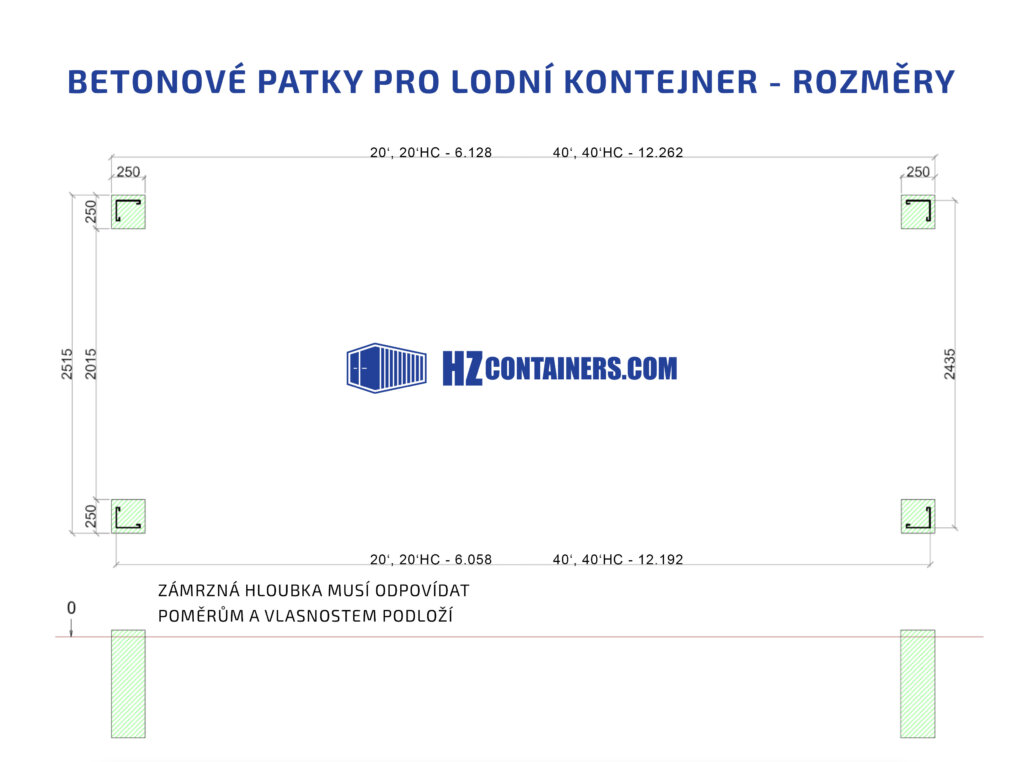Concrete footings for the container
Where to place the container after delivery?
What are concrete footings under the container? Where to place the shipping container? These are questions that everyone who wants their container to last as long as possible will need to address. You will agree that placing a shipping container on an uneven and grassy surface will not be ideal due to potential future corrosion and difficulties with opening doors, which can easily occur with a poorly positioned container. There are several suitable ways to support a shipping container…

IT DEPENDS ON THE BASE YOU HAVE AT THE SITE:
If it is an unpaved surface
1) You can have concrete footings poured under the container to level as needed, which is the best possible option. It is sufficient to pour the base only under the corner blocks of the container. That is, at all 4 points (corners).
The construction of the shipping container is self-supporting, so it is unnecessary to create footings or support the container at more points than recommended.
If you are also storing heavy materials in the container and using the total capacity of the container, we definitely recommend choosing poured footings. It is important to leave a space between the bottom of the container and the base for ventilation. Ideally, 20-25 cm.
2) A cheaper and functional option is also to support the container with, for example, sleepers, concrete tiles of size 50×50 cm, wooden shims, etc.
Here, however, it is necessary to consider how firm your base is. Because, generally, over time, the container may „sink“ slightly into the ground, so it is better to place more concrete tiles on top of each other and anticipate that the container will sink slightly into the soil over time.
This method of support is recommended if the load in the container, including the weight of the container, is not too large.
If you have the shipping container placed on an already paved surface
where there is no risk of the shipping container sinking, it is generally not necessary to support the container. It can remain on its „own“ structure, i.e., on the four corner blocks. However, it is important that there is adequate airflow underneath the container’s structure. This is to prevent moisture from accumulating under the container and to avoid, for example, mold developing on the underside of the container.
Consider the information in the text more as recommendations than precise instructions. It is always necessary to take into account local conditions, the size of the container, as well as the weight of the shipping container including the load.
Other container news...
The world’s five largest brokerage companies
With increasing globalisation and growing demand for fast and efficient transportation of goods, these companies will play a key role in shaping the future of shipping. Innovation, sustainability and technological advances will continue to be major factors influencing their strategic decision-making and enabling them to compete on a global level.
Breaking up of the MOL Comfort container ship in the Indian Ocean
The MOL Comfort container ship has become a symbol of the risks and dangers associated with maritime transport. Its breaking up in the Indian Ocean in 2013 makes us think about the safety and maintenance of ships that transport thousands of tonnes of goods around the world every day. This case reminds us that even the most advanced technologies cannot completely eliminate the risks associated with maritime transport, but they can significantly reduce them.
Air transport of shipping containers
Air freight shipping offers a fast, safe and flexible solution for the global transportation of goods. It is ideal for urgent shipments, valuable items and products with a short shelf life. Although it has a higher environmental impact, technological advances and sustainability efforts are bringing new opportunities for greener logistics.
Global warming and shipping containers
In 2017, more than 52,000 shipping vessels crossed the oceans, carrying 90% of all the world’s trade goods. This volume of shipping puts enormous pressure on the environment, making it essential to find sustainable solutions for the future.





